Cocoa is the source of all the different types of chocolate found on the market today. It is made from the fruit of the cocoa tree (Theobroma cacao). The tree has been cultivated for centuries by the Maya, and over time, has spread to tropical regions in the Americas, Africa, Asia and Oceania. What are the main characteristics of this plant that is better known in its processed form?
The cocoa tree
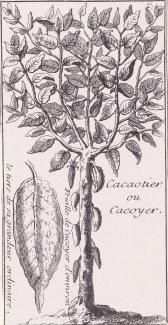 The cocoa tree (or cacao tree) is a tropical tree. It grows best in hot and humid regions of the world. In the wild, it can be found in areas around Ecuador and can grow up to 15 meters tall. This is fairly short for these regions, which allows the cocoa tree to take advantage of the shade from other trees which it needs to develop properly. The trunk can measure up to 30 centimeters in diameter.
The cocoa tree (or cacao tree) is a tropical tree. It grows best in hot and humid regions of the world. In the wild, it can be found in areas around Ecuador and can grow up to 15 meters tall. This is fairly short for these regions, which allows the cocoa tree to take advantage of the shade from other trees which it needs to develop properly. The trunk can measure up to 30 centimeters in diameter.
On the environmental side, the cocoa tree needs deep and very fertile soil, as well as favorable weather conditions that provide a large amount of rain. This is why it generally grows at low altitudes, between 400 and 700 meters.
Optimal conditions:
- • The cocoa tree needs an average temperature of 25°C to grow and it should never drop below 10°C.
- • The annual rainfall should be between 1,500 and 2,500 mm.
- • The humidity level should be 85%.
- • Dry periods should not exceed three months.
- • The cocoa tree can grow up to 1,000 m (when under the equator). It can only grow at sea level at latitude 20° north or south.
Cocoa tree flower
The cocoa tree is a cauliflorous tree, meaning that the plant and fruit grow directly on the trunk and large branches (cauliflory phenomenon). The flowers are small, less than a centimeter long, and grow all year round from the third year.
Although it bears fruit all year round, only 1 flower out of 500 will give a pod.
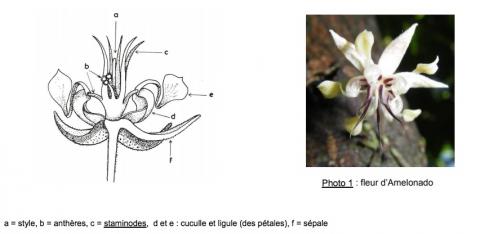
The fruits of the cocoa tree
The fruits of the cocoa tree, also known as cocoa beans, grow inside pods, which are actually large husks. These pods allow the beans to develop while protecting them from any external damage, and they also indicate the ripeness of the fruit. The pod weighs between 300g and 500g.
The color of the pods changes with the seasons and depends on the type of cocoa tree. Once it reaches its ripe color, it is ready to be harvested and opened to extract the beans. Between 30 and 50 seeds can be found in a pod.
After being harvested, the cocoa beans must be dried and roasted before becoming the raw material used to make chocolate.
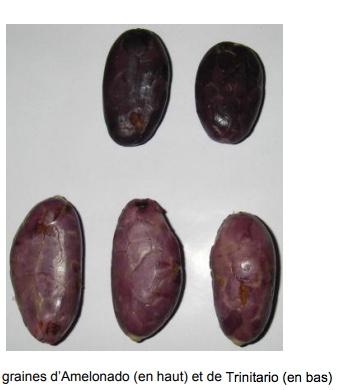
The cultivation of cocoa
The cocoa tree can yield up to one ton of beans per hectare each year, depending on the size of the trees and pods, their maturity, and the conditions in which it grows.
Harvesting takes place all year round on the equator, and the further away you go, the more the seasons are distinct. In Ivory Coast, for example, there is a difference between the "big harvest" which happens from October to February, and the "small harvest", from March to June.
Cocoa farming is still an ancestral practice, despite technological advances in all areas. It requires both expertise and human intervention in order to maximize yields. This is why harvesting is generally done by hand in two steps. First, the harvesters cut the pods from the tree to make them fall, then they open them to get the cocoa beans from the inside.
De-hulling is the process of opening the pod to get the beans out.
Although the Maya were the first to consume it, most of the cocoa tree production is concentrated in Ivory Coast, which accounts for more than a third of the world's production. Other major producing countries are located in Asia and North America.
The different types of cocoa trees
There are three main categories of cocoa trees in the traditional classification of world crops: Criollo, Trinitario and Forastero. Each of these trees produces beans that are used in a variety of ways, depending on their properties and the conditions in which they are grown.
The Criollo cocoa tree
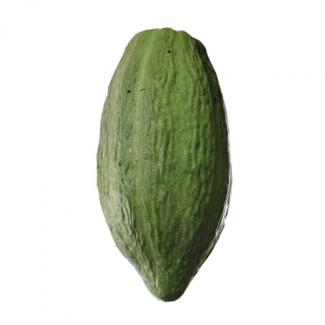 Criollo cocoa trees stand out for the flavor of their beans. In fact, this family of cacao trees is highly appreciated by chocolate makers for the preparation of luxury products.
Criollo cocoa trees stand out for the flavor of their beans. In fact, this family of cacao trees is highly appreciated by chocolate makers for the preparation of luxury products.
The cocoa from the Criollo tree group is not very bitter, and has a strong aroma and a remarkable finesse on the palate. Although the sweet flavor of these beans is appreciated in the industry, it isn't produced in large quantities by farmers because these trees are fragile and susceptible to diseases.
Today, this type of cocoa tree is much less present on the cocoa market (barely 0.1% of the world production) compared to other species. However, Criollo beans tend to ferment easily. Vegetative propagation, a common reproduction method in cocoa tree cultivation, is not easy with this type of tree.
The Trinitario cocoa tree
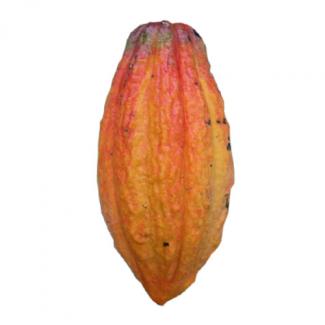 The provenance of the Trinitario cocoa group is unclear. However, it is very likely that they are hybrids from a cross between a variety of Criollo and Amazonian Forastero. The quality of their cocoa and their distinctive features seem to indicate that they are the result of a subtle blend between these two groups. The color of the beans, the size of the trees and the shape of the pods can vary depending on the species of Trinitario.
The provenance of the Trinitario cocoa group is unclear. However, it is very likely that they are hybrids from a cross between a variety of Criollo and Amazonian Forastero. The quality of their cocoa and their distinctive features seem to indicate that they are the result of a subtle blend between these two groups. The color of the beans, the size of the trees and the shape of the pods can vary depending on the species of Trinitario.
The elusive and somewhat intermediate botanical character of this group of cocoa trees is appealing to chocolate makers. The Trinitario cocoa tree accounts for between 10 and 15% of the world's cocoa-producing trees. The different varieties of this group of trees are cultivated in many countries, such as Venezuela, Brazil, Mexico and Cameroon.
The Trinitario trees have red pods, like the Criollo, which turn orange as they ripen. On average, 150 pods are produced by one tree in one year, which is equivalent to about 6 kg of cocoa.
The Forastero cocoa tree
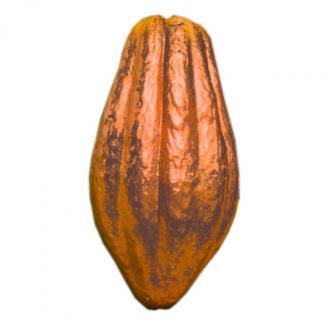 This is certainly the most cultivated group of cocoa trees in the world. In fact, it accounts for 80% to 90% of the world's cocoa production. The Amazonian Forastero are so common on cocoa farms because of their resistance to disease and because they mature quickly. This type of cocoa tree has other advantages such as its vigor and high productivity.
This is certainly the most cultivated group of cocoa trees in the world. In fact, it accounts for 80% to 90% of the world's cocoa production. The Amazonian Forastero are so common on cocoa farms because of their resistance to disease and because they mature quickly. This type of cocoa tree has other advantages such as its vigor and high productivity.
Forastero trees grow in West Africa, Central America, North and South America, Brazil and Ecuador. Because of its high yield and ease of cultivation, this type of cocoa tree may well become more widely grown in the future. The quality of most Forastero cocoa beans is considered "standard", while the variety grown in Ecuador offers superior cocoa quality.
This group of trees is recognizable by its smooth yellow and green pods, its purple-colored almonds and the bitter taste of its cocoa. The cocoa beans of these cacao trees contain a large amount of tannin. This type of tree has 30 to 40 cocoa beans per pod.
New classification of cocoa trees
In 2008, researchers from the study "Geographic and Genetic Population Differentiation of the Amazonian Chocolate Tree (Theobroma cacao L)" suggested a new, more accurate classification based on genetic criteria. This study shows that the germinative plasma (DNA) of cocoa trees was still poorly understood and that the traditional classification method based on two genetic groups, the Criollos and the Forrasteros, was overly simplistic and confusing (misidentification of plants).
The ten groups suggested in the study are : Amelonado, Criollo, Nacional, Contamana, Curaray, Cacao guiana, Iquitos, Marañon, Nanay, Purús
This classification is recommended for both wild and cultivated cocoa trees and allows producers to better assess the characteristics of their plantation through the proper identification of the trees.
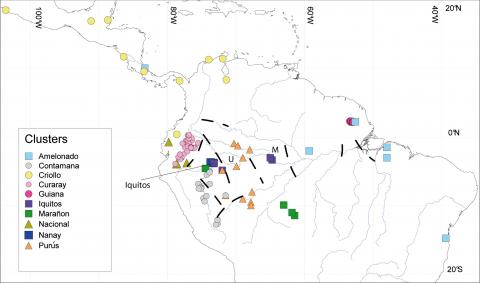
Amelonado cocoa tree
The Amalonado cocoa is unique in that it has dark purple beans. It is quite fatty, but also a bit bitter and releases aromas of coffee, wood and spices (mainly cinnamon and vanilla).
The Amelonado gets its name from its round melon-shaped pod. It is mostly found in French Guiana, which suggests an eastern Amazonian origin. It used to be found in West Africa, but it is disappearing, wiped out by the production of hybrid cocoa trees, which are extremely prolific.
Criollo cocoa tree
The Criollo cocoa tree can be found in Venezuela and is characterized by its unique vertical branch. Its pods are warty, which means that they are not smooth, but have protrusions. They are yellow and often turn green or red. Its seeds are large, but rarely exceed the number of 50 per pod, which reduces its chances to reproduce.
The Criollo requires a short fermentation time and a quick roasting at low temperatures. It has a delicate flavor and is not very bitter. The Criollo is a very old crop, dating back to pre-Columbian times. It was highly prized by the Mesoamericans, who appreciated its fine taste that could be savored pure.
The Criollo has survived for centuries, but it is complicated to cultivate, which has made it somewhat obsolete. Its yields are low, but also variable, which is risky for the growers who choose to grow it. These trees are fragile, particularly because of the thin skin of the pods.
The fragility of the cocoa means that it is rare. Nevertheless, the finesse of its aromas is such that it remains a highly coveted cocoa.
Nacional cocoa tree
Nacional is a very fine cocoa with purple-red beans. They can also be pale white, and they darken during fermentation. The tree is medium in size, with oval-shaped yellow-orange pods when they are ripe.
Nacional is naturally sweet, not very bitter, nor very fatty. It has a unique bouquet of aromas that combine floral violet, lilac, jasmine and orange blossom. Depending on its origin, it can exude fragrances of black figs and cinnamon.
According to its DNA, the Nacional is a distant subspecies of the Amazonian types and is not related to the Criollo. It probably originates from the foothills of the Andes, drained by the rivers of the upper Rio Marañon where it still thrives.
The Nacional is considered to be the traditional Ecuadorian cocoa, although it is also present in Peru. However, its vulnerability to disease makes it difficult to cultivate and is being replaced by more resistant species.
There have been attempts to transplant it elsewhere with limited success. Trees grown outside Ecuador rarely produce the same floral finesse as in its native territory.
Contamana cocoa tree
Contamana is related to Nacional cocoa. However, it is more robust and its small purple seeds have a slight bitterness. Its flavor reminds us of dried brown fruits and flowers. Contamana was discovered by FJ Pound in 1937 in the Ucayali River Valley in Peru.
FJ Pound was an agronomist from the Department of Agriculture in Trinidad. He was looking for a cocoa tree that could resist witches' broom disease. Witch's Broom disease is caused by the Crinipellis perniciosa pathogen and the Nacional is highly susceptible to it. This disease can strike at any time and last for years. The fungi it causes cause an anarchic development of the axillary buds.
Pound was satisfied with the Contamana, which has the ability to effectively neutralize the witches' broom disease.
Curaray cocoa tree
Curaray cocoa gets its name from the Peruvian river of the same name. It has similarities with other varieties from the same Amazon region: the Nacional, Contamana and Iquitos. Its genetic structure has common characteristics with those of the Nacional and the Criollo. However, Curaray grows in a small area in the Amazon region of Ecuador, unlike its relatives which tend to cover larger areas.
Curaray has not yet been studied enough to determine its specific characteristics and continues to be produced in small quantities. Research efforts, genetic manipulations and hybridizations could be considered to make better use of it.
Guiana cocoa tree
Guiana has a high number of small seeds, which is considered a defect by growers who find it difficult to cultivate it in large quantities. Guiana has a very fine taste with a slight bitterness. Its strong aromatic intensity is attributed to its high content of purine, an organic aromatic compound found in cocoa that delivers delicious flavors.
Guina is mostly found around the Camopi, Oyapok and Tanpok river basins in southeastern French Guyana. It is known for its genetic originality and extreme robustness. It is capable of resisting to many diseases, especially the witches' broom.
Iquitos & Nanay cocoa tree
Iquitos and Nanay cocoa come from the same region of Peru. Iquitos is a department of the Peruvian Amazon deep in the heart of the forest. The Nanay is a river that flows into the Peruvian Amazon. These are extremely dense forests where the cocoa tree is very popular.
The Iquitos and Nanay cocoa are quite bitter. Their flat seeds are purple or violet and generate tannins that give body and fullness to the chocolate they produce. However, they require more careful processing (longer fermentation and higher roasting temperature) to reduce the inherent bitterness, acidity and astringency. The final result is of great finesse. When they do not benefit from these additional treatments, these Amazonian cocoa beans do not perform well in the production of low-end confectionery.
Iquitos and Nanay cocoa trees are known for their vigor and resistance to disease. They can grow in the wild or be cultivated on a large scale. These two varieties are grown by two types of producers: those who prefer quantity and those who prefer to limit their production to focus on quality. The flavors stand out during the fermentation and roasting process.
Marañon cocoa tree
Cocoa farming is widespread in the Marañón Canyon. The cocoa from these trees is considered to be of high quality. Marañón has been produced from wild cocoa trees for a long time in this valley. According to historical records, the beans were already harvested at the beginning of the 20th century.
Since then, they have been cultivated and selected to produce the finest quality beans. The best quality trees are isolated and then they are used to create new plantations. The farmers follow very closely the potential appearance of diseases to eradicate immediately. The treatments are as organic as possible and the farms are very productive, with harvests of excellent quality.
The traditional cultivation of Marañón is very labor intensive. When the rules are followed, the pods are harvested manually and rigorously selected. Almost half of the beans are white (at least 40%). The entire harvest is then processed as naturally as possible, on tables specifically design for fermentation. They are then regularly turned over - always by hand - and dried in the sun under tarps.
If this process is respected, farmers can get beans of exceptional quality with a fruity and floral taste, which are then turned into chocolate.
Purús cocoa tree
Purús cocoa is found in Brazil near the rio Purús, in the area surrounding the cities of Maracaju and Boca do Acre and the Arapixi reserve. It grows mostly in the wild, on one of the most fertile lands in the Amazon, characterized by an alluvial and clayey soil.
However, the fact that these trees are scattered makes it very difficult to harvest them. Harvesters have to travel in canoes on the Rio Purús. After landing to pick the beans from a few trees, they return to their boat and paddle to another strategic place where other cacao trees are growing. The productivity of their farm is therefore very low.
Purús cocoa is known for its intense color. Its pods are quite small and are predominantly yellow. The flavors are quite spicy and very rich. Purús cocoa allows the production of very high quality chocolates, but they are often expensive because they require a lot of labor to be harvested.